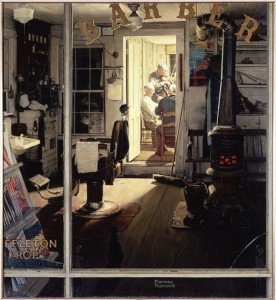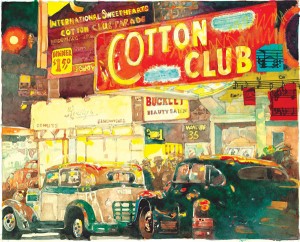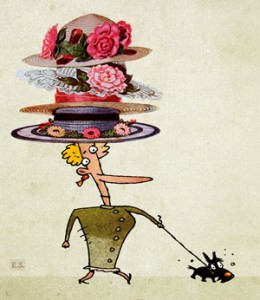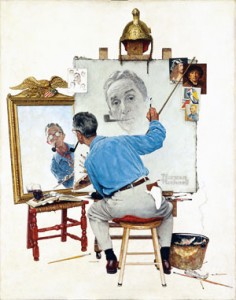
"Shuffleton’s Barbershop," Norman Rockwell, 1950. Oil on canvas, 46 1/8” x 43 3/8”. Cover illustration for "The Saturday Evening Post," April 29, 1950. Collection of The Berkshire Museum, Pittsfield, Massachusetts.©1950 SEPS: Curtis Publishing, Indianapolis, IN.
This year Norman Rockwell Museum’s Deputy Director/Chief Curator Stephanie Plunkett was interviewed by Print magazine regarding the Museum’s past, present and future. Her thoughts appear in the August issue of the time-honored publication (on sale now). Here are excerpts from the original interview that she conducted with writer/visual historian Steve Heller:
Before we start talking about the Norman Rockwell Museum, can you tell me how, after getting a masters in illustration, did you join the museum’s ranks?
I came to the MFA Illustration as Visual Essay Program at the School of Visual Arts with a great appreciation for the art of illustration, and for the creators who work behind the scenes to create imagery for mass publication. My father was an illustrator and graphic designer in New York City agencies, and I witnessed the extraordinary dedication that made art for commerce possible. I think I always wanted to find a way to speak publicly about the contributions of artists who work quietly and sometimes anonymously in the name of commerce, but wasn’t quite sure how until I saw an advertisement for employment at the Norman Rockwell Museum. Fortunately, my sixteen years at the Museum has provided many opportunities to do just that.
Norman Rockwell is a fascinatingly complex American figure. His art seems so on the surface, but he had many facets. Is the museum a testament to the complex man or the iconic art – or both?
The Museum was established more than forty years ago, and for the first thirty, curatorial emphasis was placed solely the life and art of Rockwell himself. This was an advantage, as it allowed Museum scholars to tease out, through many years of study, the intricacies and realities of Rockwell’s existence, and the impact of his imagery on the American psyche. Processing his vast archive of reference photography, fan and business correspondence, and personal ledgers and affects, has made important twentieth century artifacts relating to art for commerce available to other commentators as well, greatly advancing the conversation about Rockwell and the field. In presenting his art—at the Museum in Stockbridge, throughout the world, and in publication—we tell Rockwell’s story by presenting a layered view that represents his experiences, his influences and aspirations, the complexities of his world, and the iconic images that are his legacy.

Illustration from "The Sweethearts of Rhythm," Jerry Pinkney, 2009. Featured in the Norman Rockwell Museum exhibition "Witness: The Art of Jerry Pinkney." ©2009 Jerry Pinkney Studio. All rights reserved.
Since you have been at the museum it is safe to say that the depth and breadth of what is covered has expanded. Political art (an exhibition of Steven Brodner), children’s art (an exhibition of Fred Marcellino), and recently a new contemporary art series (launching with Elwood H.
Smith). Two questions: has this been a difficult transition, given the core “Americana” audience?
I am thrilled to report that the Norman Rockwell Museum has exhibited the art of almost 450 historical and contemporary illustrators, and have no doubt that Rockwell would have been incredibly pleased to have his art exhibited among that of his colleagues. He was proud to be among “the band of illustrators who have shown us to ourselves,” and it has been an honor to highlight the accomplishments of these gifted creators, both here in Stockbridge and through traveling exhibitions that make their way to museums throughout the nation.
With regard to your question, there are two significant issues at play. No subject can be truly understood without the benefit of context, and the history of this dynamic American art form is an essential aspect of the story that the Museum aspires to tell. Our commitment toward advancing knowledge and understanding relating to the field is reflected in the recent formation of the Rockwell Center for American Visual Studies, the nation’s first scholarly institute focused specifically on the images of mass culture in our world. We are about to award the Rockwell Center’s first fellowships to graduate and post graduate students, who will bring new contextual thinking forward and inspire fresh consideration of the art of illustration in academic institutions and museums. I think your readers will enjoy Rockwell Center Curator Joyce K. Schiller’s essays in visual studies, which can be found at www.rcavs.org.
Another consideration is that Rockwell is now a historical figure, and the audiences who experienced his illustrations for the covers and pages of The Saturday Evening Post and other publications first-hand are dwindling. Engaging with new audiences is essential to the Museum’s future, and changing exhibitions that present diverse aspects of the field help us to do that. Of course, there are those who want to experience only Rockwell when they visit, and the Museum’s name does not reflect our broadened mission, which can be confusing. Public response to the Museum’s illustration exhibitions has been very positive, though, and many noted American institutions that have mounted the illustration-based exhibitions that we have organized, which is both gratifying and important for the Museum and the field.

“Too Many Hats,” Elwood H. Smith, 2010. Featured in the Norman Rockwell Museum "Elwood's World: The Art and Animations of Elwood H. Smith." ©2010 Elwood H. Smith. All rights reserved.
What are your criteria for a “Distinguished Illustrator” in your new series? And who are you looking at for future exhibitions?
We recently mounted Elwood’s World: The Art and Animations of Elwood H. Smith, the first in a series of Distinguished Illustrator exhibitions honoring the unique contributions of contemporary visual communicators, a venture that we are very excited about. The Museum’s curatorial goal is to examine and document the art of influential creators who have made a life-long commitment to the field, and who have inspired new ways of seeing. So many are deserving of recognition, and as you may imagine, our list of potential artists is very long. The decision-making process is both exhilarating and excruciating.
These intimate single-artist installations are designed to reflect both the evolution and the essence of each creator’s vision. Their manageable scale will allow the Museum to feature at least two artists annually, in addition to our larger thematic exhibitions. We hope to make the series broadly accessible through travel to museums and university galleries, and through digital publication. If anyone would like a copy of Elwood Smith’s monograph, to which Steve contributed a fantastic piece, please drop me a line. The amazing illustrator, animator, and book designer, Istvan Banyai, will be the subject of the next Distinguished Illustrator exhibition, on view in early 2012.
Rockwell’s work has become a brand – a commodity too – is there anything taboo in how his work, and the work of others, is presented?
In exhibitions and publications, we strive to present an honest view, despite and because of Rockwell’s legendary status. He suffered through trials and tribulations, as we all do, and often painted his happiness. It’s important for the public to know that beneath all that he has come to represent, Rockwell was deeply human. He accomplished his work with unflinching devotion despite the strains inherent in daily living. His brilliance was countered by depression, divorce, the death of a spouse, artist’s block, and professional concerns, all important aspects of his story that impacted the art that he produced. As a historical figure, he holds up well as a compassionate humanist who was fully committed to his art.

"Triple Self-Portrait," Norman Rockwell, 1959 Oil on canvas, 44 ½” x 34 1/3”. Cover illustration for "The Saturday Evening Post," February 13, 1960. Norman Rockwell Collections. ©1959 SEPS: Curtis Publishing, Indianapolis, IN
Do you think that there can ever be another Rockwell – an artist that captures the heart of the American people? Or is that era over?
I think that Rockwell was the last illustrator to have that kind of reach, as the world of publishing and communications has changed so dramatically. When Rockwell achieved success, print media was the public’s primary source of information and entertainment, and television was not even a glimmer on the horizon. Today our attentions are vastly diverted by a plethora of visual and informational sources, some of which are small enough to hold in the palms of our hands. So many letters in Rockwell’s archive speak to the public’s focus on illustrated images in mid-century America. Correspondence corrects the amount of postage on a package carried by a fictional GI, offers a list of adjustments to the artist’s Four Freedoms, and makes suggestions for future magazine covers. We are continually struck by just how personal it all was, and how difficult it would be to capture the public’s imagination so completely in our time. Still, there is so much exciting work being done, and it is our hope that in this very fast paced world, we can inspire audiences to slow down for a moment and take it in.
Thanks to Steve Heller and the staff at PRINT magazine. Article ©PRINT magazine. All rights reserved.

